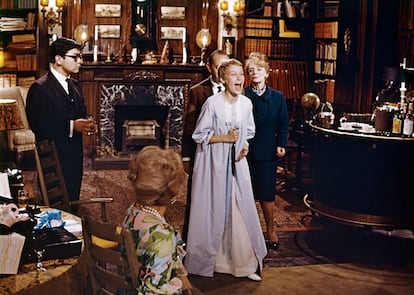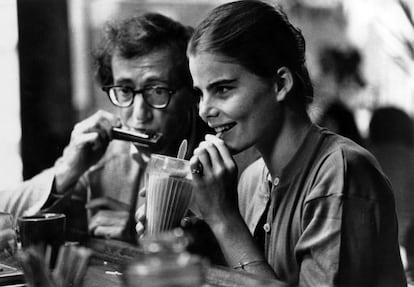Claire Dederer, the essayist who dissects the ‘monsters’ of culture: ‘Ignoring them will not make you a better person’
In her latest book – ‘Monsters: A Fan’s Dilemma’ – the American author examines the idea of being able to separate artists from their work, despite their personal behavior


The day that Claire Dederer, 56, was going to participate in a radio documentary about Rosemary’s Baby (1968), she destroyed her face.
Roman Polankski’s most acclaimed film had been released just a few months before the murder of his wife, Sharon Tate, who had composed the soundtrack. Meanwhile, the producer of the movie was on the verge of dying, while Mia Farrow was served with divorce papers while on the set. Perhaps influenced by all these terrible events, Dederer slipped on her way to the radio station. She ended up with an open wound, scraped skin and several broken teeth. Crouching on the sidewalk, bleeding – while the rest of the passersby looked on in horror – she realized that she had become what her favorite director was for many people during that period of time: a monster.
Three years before the Me Too movement, this cultural critic was already tormented by the idea of what she should do about her love for “a disgusting genius.” In an interview with EL PAÍS via videoconference from her home in Seattle, she explains that, despite knowing all the details about Polanski’s anal rape of 13-year-old Samantha Gailey at Jack Nicholson’s house in 1977 – despite the boycotts, lawsuits and public outcry against the director, despite considering herself a good progressive feminist of her time, she continued to enjoy his work.
So, one rainy afternoon, in 2014, she decided to watch all his movies again. She believed that, in her living room, surrounded by books, “everything could be cured by thinking.” The movies seemed beautiful again; furious, chilling and relentless. The biographical information of the director barely hovered over that room.
By the time 2017 arrived – when women and girls channeled their anger into revealing various atrocities that they had been subjected to by other artistic geniuses – Dederer decided to publish an essay in The Paris Review. It went viral. Titled What Do We Do with the Art of Monstrous Men? she wondered precisely about the answer to this question. What happens when someone – such as Polanski, Picasso, Hemingway, Michael Jackson or Woody Allen, among many other names – did something terrible, but created something great?
That text eventually gave rise to Monsters: A Fan’s Dilemma, a book that’s nearly 300 pages long and explores the moral dilemmas faced by the fans of artists. They often make ethical decisions, although they are, in fact – in the author’s opinion – deluding themselves. Her reflection breaks with the idea of cultural criticism being an authority and arbitrator. Instead, Dederer opts for an affective shift when it comes to the judgement of art. What are we, after all, if not a bundle of feelings?
Question. Can the artist be separated from their work?
Answer. I think, at first, when I started thinking about this problem, that was how I framed the question. What’s the relationship between the art and the artist? Can we separate the art from the artist? Should we separate the art from the artist? And then, I [realized that] this notion of two separate things was impossible. And that the integration of art and artist was something that was already sort of always occurring.
Q. To symbolize this impossible partition, you resort to the metaphor of “the stain.” In the book, you wonder if listening to Michael Jackson in his Jackson 5 era is more liberating than putting on songs from his adult era. The stain – as you say – has a retroactive effect.
A. The idea of trying to separate the artist from the work is like trying to separate a fiber from a wine stain. It’s not going to happen.
Q. You write that the internet and the democratization of access to information have been key to exposing the “stains” of artists. In the past, the biographies of artists were elusive. But today, biographical information permeates everything: even if we don’t look for the information, it hijacks our attention.
A. When I was a child, it was very difficult to know something personal about an artist who fascinated me. A biography had to have been published… and you had to be able to access it. I still remember, as a teenager, how amazed I was when I got one of those books. This [experience] has been lost. It’s no longer like when you used to go to a record store and choose [an album] when you were intrigued by the cover photo or the typography. We no longer approach art without prior information. We are continually bombarded. This is how the internet works: I share my biography, you share your biography on social media, then we consume other people’s biographies all the time. There’s no escape. It makes me sad.
Q. Why?
A. Because we will no longer be able to have that dream of the encounter, of a perfect transmission between artist and observer. We’ve lost the ability to face the work alone, to have that be the only thing between sender and receiver. Now you can’t help but do it knowing all that biographical information that has reached you, whether you sought it out or not.
Do you know who Carrie Brownstein is? So, I accidentally bumped into her (the musician). And it was great because I was with my daughter, who’s like a Sleater-Kinney superfan (Brownstein’s rock trio). It was this really fun, random moment in New York City. And we were chatting about what she was doing with her day. And I thought: “this is a luxury now.” Being able to not experience biography [has become a luxury].
Q. What makes a monstrous artist? In your book, you cite part of the definition that writer Jenny Offill gave to “art monsters” in her novel Dept. of Speculation (2014): “My plan was to never get married. I was going to be an art monster instead. Women almost never become art monsters because art monsters only concern themselves with art, never mundane things. Nabokov didn’t even fold his own umbrella.” That quote, precisely, resonates greatly among the creatives of this generation.
A. I think that if that extract [has become so popular], it’s because women drea of the idea of becoming a monster. They don’t think: “Wow, I’d love [abandon] my kids.” But there’s something aspirational about that phrase, right? [And] why do some of us consider the act of closing the studio door and ignoring others to be monstrous? This is the kind of question that interests me and the kind that – as a memoirist – I ask myself.
Q. Do you think that the real monstrous artists are those who abandoned their children to create, such as the novelist Doris Lessing or singer Joni Mitchell did?
A. The book is very personal: it’s an assertion of the power of subjectivity. As a mother of two children, that idea has always invaded my mind. Every moment I’ve spent with my children, I could have been creating, right? That doesn’t mean I don’t want to be with them… but there’s an elastic sense [surrounding the renunciation] of parenting.
While I was writing this book, I was going to be gone for a few weeks, at a writer’s residency. My kids were in high school at the time. And [I was thinking]: “if I’m gone for a week, am I abandoning them?”
I’ve always had this feeling that, if the [worst] male crime is rape, the worst crime a woman can do is leaving their child. And so, [in this book], I also really wanted to explore what is truly the most monstrous thing a woman can do.

Q. You write about the 20th century: “Insensitivity, cruelty, masculinity and brutality shaped the image of geniuses.”
A. I’m very interested in the idea of how Picasso and Hemingway – together with the mass media – built the idea of the artist-genius in their likeness. [It was] a very sexy and commercial [idea]. That image was brutal, because it was that of a man devouring women. It was harmful.
Q. One aspect that you explore is how artists who did nothing monstrous can be tarnished by their work, as happened to Nabokov with Lolita (1955).
A. What scares me the most is [how a work can be] condemned for its content. In Lolita, it was because of the portrayal of pedophilia. With Philip Roth, it was sexism. With James Salter, it had something to do with the exploitation of a young woman. Condemning art because of its subject matter is dangerous.

Q. You also believe that this idea of justifying the monstrous artists of the past by claiming that they acted badly because of the era they lived in or their idiosyncrasies is erroneous. You also say that the citizens of the present – the adults of the world – haven’t improved, either.
A. We just have to pay attention to everything that’s happening around us. I think the idea of how imperfect we are has never been more crystal clear.
Q. You find the notion of “consuming” art – of being a “consumer” – to be problematic, because that concept isolates us from structural and collective changes.
A. [As a consumer], I want to assert myself as a good person. [For example]: I feel terrible about climate change, so I’ll stop using plastic straws. This solves truly nothing. I mean, maybe you’ll get furious letters saying it does solve something… [but the truth is] that it’s a limiting notion. The limiting notion of the self as a consumer is so much more poisonous than whatever good comes from [reduced] straw use.
If you see my point, this idea that I – as an atomized consuming individual – am the agent of change is the source of all that is wrong [with our society]. This idea that we’re not part of a collective, that we don’t need to join with other people to solve problems. When we devolve to that role – which is how we constantly devolve [in the United States] – we disempower ourselves.
Q. And how does all this apply to our relationship with the art of monstrous men?
A. It’s a bit of the same thing. We want to create this narrative that we’re good people, that we’re making an important choice by not consuming a monster’s art… but we’re not actually changing anything. The way you consume art will not make you a better or worse person – you will have to find another way to do this.
Q. Despite everything, do you still love Polanski?
A. What do you want me to say? I think that Rosemary’s Baby is the work of a genius. I love Repulsion (1965). I love his work. But after writing this book – and after having this book tour and all this coverage from the press – right now, I’m very tired of Polanski.
Sign up for our weekly newsletter to get more English-language news coverage from EL PAÍS USA Edition
Tu suscripción se está usando en otro dispositivo
¿Quieres añadir otro usuario a tu suscripción?
Si continúas leyendo en este dispositivo, no se podrá leer en el otro.
FlechaTu suscripción se está usando en otro dispositivo y solo puedes acceder a EL PAÍS desde un dispositivo a la vez.
Si quieres compartir tu cuenta, cambia tu suscripción a la modalidad Premium, así podrás añadir otro usuario. Cada uno accederá con su propia cuenta de email, lo que os permitirá personalizar vuestra experiencia en EL PAÍS.
¿Tienes una suscripción de empresa? Accede aquí para contratar más cuentas.
En el caso de no saber quién está usando tu cuenta, te recomendamos cambiar tu contraseña aquí.
Si decides continuar compartiendo tu cuenta, este mensaje se mostrará en tu dispositivo y en el de la otra persona que está usando tu cuenta de forma indefinida, afectando a tu experiencia de lectura. Puedes consultar aquí los términos y condiciones de la suscripción digital.
More information
Últimas noticias
Most viewed
- Sinaloa Cartel war is taking its toll on Los Chapitos
- Oona Chaplin: ‘I told James Cameron that I was living in a treehouse and starting a permaculture project with a friend’
- Reinhard Genzel, Nobel laureate in physics: ‘One-minute videos will never give you the truth’
- Why the price of coffee has skyrocketed: from Brazilian plantations to specialty coffee houses
- Silver prices are going crazy: This is what’s fueling the rally










































